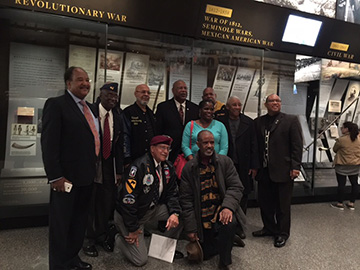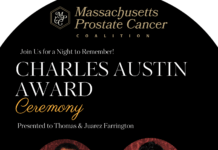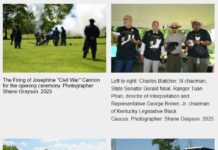![]()
![]()
![]()
![]()
![]()
![]()
 Call for General Colin Powell’s uniform to be removed from the display
Call for General Colin Powell’s uniform to be removed from the display
by Charles Blatcher, III Chairman, the National Coalition of Black Veteran Organizations
On February 20th, representatives of the National Coalition of Black Veteran Organization conducted a review of the National Museum of African American History and Culture in Washington DC. The review was the result of members of the Coalition Organizations voicing concern about how the Military History has been depicted in the collection. The Coalition made a request to meet with the Curator of the military history collection to provide explanation of the storyline of the dispersed presentation. The institution did not acknowledge our request. Instead, the group conducted the tour without the benefits of any staff to guide us through the massive facility.
The review team was composed of representatives:Michael Theard, President, Buffalo Soldiers 9th and 10th Horse Cavalry;Howard Jackson, Chairman, National Minority Military Museum Foundation; Artis Copeland – President , USCG National Association of Former Stewards and Steward Mates;Dr.AV Hankins, President, – ACE Museum ; Hardwick Crawford – Buffalo Soldiers 9th and 10th Horse Cavalry; MZO Bradley, Honorary Counsel of Sierra Lorne and West Africa, Georgia Eaves- Commander – DAV Dorie Miller Post ; Donald Christiansen – The Triple Nickle Paratroopers; Reverend Rodney Bennett – Maysville, Kentucky Cabin Committee, and Reverend John E. Reese, Jr. – Kentucky and myself. We were given access at 3: o’clock pm and the facility closed at 5:30 pm not allowing much time for the review.
As a member of preliminary planning team for the museum in 2004, under the Department of Interior, this was my first opportunity to view the finished facility. My opinion of the museum as it stands, is mixed. The physical appearance of the facility is striking. The architectural splendor was amplified by the sunlight dancing off of the bronze medal tapestry that graces the top outer façade of the building. The edifice without question is gorgeous. The sight was so impressive that I felt it necessary to remind the group of our mission. Our purpose was to examine the facility’s content as it relates to military history.
We ran out of time without having the opportunity to visit the third floor. Reading the flow of the building, the basement represents the pre-colonial through Slavery time-period as the foundation of the history. The second floor Community Gallery combined contemporary and Military History. The top floor in the Crown shaped structure is dedicated to Sports and Entertainment. While those things are important, are they the crowning achievements of our decades of struggle for freedom and equality?
In honor of Crispus Attucks, a correction should be made
We began on the second floor in the Community Gallery that housed the main body of the Military History. As we discussed what was, was not, or misleading in the presentations, we drew a crowd. People began to ask us questions regarding the history. Explanations were in order. The pictures focused on the “What” factors of the history. The legends explained the “Who and where.” The most important factors of “Why” was not so obvious.
We started with Crispus Attucks identified in legend as the first person killed in the “Boston Massacre,” the event that sparked the Revolutionary War. Four other colonists died on March 5, 1770, with Attucks. They were Samuel Gray, Patrick Carr, Samuel Maverick and James Caldwell. If properly stated, Crispus Attucks was among the first to fall.
One could ask, does our Military History really matter? YES! Our primary pursuit in American History has been to overcome persecution, in the political, social and economic arenas. One of the most significant contributions made to claim our equal entitlement is through our military service. The death of Crispus Attucks and the four other Colonists set the course for this nation’s call for independence.
The original outcry for a national museum came from Black Veterans during World War I. Which caused one to wonder how the subject of Military History garnered such a small footprint in this massive facility? Our military contributions are the cornerstone of our claim for Civil Rights in this nation. It took eighty-six years before the passage of legislation authorizing the development and construction of the National Museum. The legislation was submitted by Representatives John Lewis (D-GA), JC Watts, Jr., (R-OK), Sam Brownback, (R-KS) and Senator Max Cleland, (D- GA) in 2001. It was approved in 2003 by then President George W. Bush. As the principal advocate calling for a National Museum of Minority Military History in 1978, I was invited to be a member of the Preliminary Planning Team under the Department of Interior. This recent visit to the Museum was my first opportunity to tour the finished project.
As we strolled through the glossary of facts in the Community Gallery, the Team questioned the placement of the Military History in the Community Gallery. Our military history is national in scope.
–The death of Crispus Attucks was an influencing factor in Black participation in the American Revolutionary War. Including our histories in the War of 1812, Civil War, the period of the Buffalo Soldiers, the Spanish American and World War I Eras, with World War II and the Korean and Vietnam Conflicts the history exceed the three thousand square feet allocated in the existing presentation.
–Call for National Museum of Minority Military History
Foremost, our Military History is too important for a glossary presentation. Now that the Museum has demonstrated its inability to handle the subject in its confined space, we once again call for a National Museum of Minority Military History.
–Buffalo Soldiers
A presentation on the Buffalo Soldiers alone could acquire three thousand square feet. The history of Colonel Charles Young a(notable history) could take up a sizable portion of that space. Young is shown. here at right.
–There should be a display of the 369th, 370th, 371st and 372nd Infantry Regiments of World War I. The regiments distinguished themselves fighting under the command of the French Army. There should be room for one of the Tanks used by the 761st “Black Panther” Tank Battalion when they became the first Allied Force to cross the Rhine River entering German in World War II. The current display includes the Tuskegee Spirit Aircraft hanging from the ceiling of the facility. Instead there should be a P-51 Mustang like the ones flown by the 99th Pursuit Squadron when they escorted the US bombers in route to Germany. There should be a mail room display such as the one serviced by Black Women in the 6888th Postal Battalion and a World War II parachute to introduce the history of the first Black Paratrooper Battalion, the Triple Nickles. How about including a truck of the type driven by the “Red Ball Express” and a whale boat, like the one used by the Black Coast Guard Lighthouse Keepers in WWII. There should be a display of the Black Marines in action in the Pacific War Theatre, the Black Nurses who served in Liberia, and the Black Engineering Battalion who constructed a portion of the Alaska/Canadian Highway in World War II. The displays should acknowledge the 275th Black Signal Battalion. They hung telegraph lines in the jungle of Panama. The 320th Anti-Aircraft Barrage Balloon Battalion who served on Omaha Beach during the DD Invasion; the Navy Black Steward Mates should be presented in a service environment. Seaman Dorie Miller should be displayed manning an anti-aircraft gun.
–There was no mention or sizable notice of anything about the Brownsville Incident. It was a racial incident that grew out of tensions between whites in Brownsville, Texas in 1906 and Black Soldiers of the 25th Infantry Regiment stationed at nearby Fort Brown. The incident resulted in
the dishonorable discharges of 167 enlisted men. The trial resulted in the largest Military dismissal in the history of the Armed Forces.
–Colonel Charles Young is one of the most significant Black Soldiers to serve during the Spanish American and World War I Eras. However, the significance of his history is marginalized in the presentation.
–The uniforms missing in the museum‘s current display are more notable than the one’s mounted. Missing are the uniforms and histories of the pioneer Generals and Admirals who contributed to the day when we had the nation’s first Black Chairman of the Joint Chief of Staff and Commander in – chief. General Colin Powell’s uniform while standing in splendor, should be removed. Standing alone when so much is missing regarding recognition of the others is less than complimentary. The following uniforms should be added to that presentation: Brigadier General Benjamin O. Davis, Senior, USA – first Black General Officer in the United States Armed Forces; Lt. General Benjamin O. Davis, Junior, USAF – first Black General Officer in the United States Air Force; General Roscoe Robinson, USA – first Black Four Star General in United States Military History; General Daniel “Chappie” James, USAF – the first Black Four Star General in the United States Air Forces; Brigadier General Hazel W. Johnson, USA – the first Black Woman General in United States Military History; Lt. General Frank Peterson, USMC – the first Black General in the United States Marine Corps; Vice Admiral Samuel L. Gravely, USN – the first Black Admiral in the United States Navy; Admiral Paul Reason, USN – the first full Admiral in the United States Navy; General William E. Ward, USA – the first Black General in charge of the US/Africa Command; Lt, General Arthur J. Gregg, USA and Lt. General Emmett Paige, USA – both climbed the ranks from Privates retiring as Three Stars Generals; Major General Charles Rodgers, USA – the only Black General recipient of the Medal of Honor and Colonel Charles Young, the highest Black Officer in the United States Armed Forces during World War I. There should also be a few civilian suits in the display: Clifford L. Alexander, Jr. – the first Black Secretary of the Army; Togo D. West, Jr. – the second Black Secretary of the United States Army; Former Congressman Ronald V. Dellums – the first Black Chairman of the House of Representatives Armed Services Committee and the Honorable Barack H. Obama, the first Black Commander in-chief of the United States Armed Forces.
Borrowing a phrase from an old friend of mine, Retired Sergeant Samuel Waller, USCT,
“The What factors in history is only important if you understand Why.” The story still remains to be told.
In closing on a positive note, I had the past opportunity to visit the Imperial War Museum in London, England a few years ago. The purpose was to inventory their photograph collection on Black Military History. The collection is extensive. The photographs were a part of the United States Army’s Public Relations Program as it related to Black participation in World War II. Some of the photographs have never been seen in the United States. The Army chose to give the materials to the British Government as opposed to bring it home at the conclusion of the War.
The Coalition would like to invite the National Museum of African American History and Culture, in Washington, DC and the National Afro American Museum of History and Culture in Wilberforce, Ohio to work with us to bring the pictorial collection home to the United States for a national tour. We will ask our Coalition Partners to host the collection on a tour around the country.
For additional information contact: cnmmmf@aol.com






